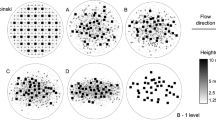Abstract
A wind-tunnel study of the roughness effect of a network of uniformly spaced long parallel windbreaks has been attempted. The roughness parameterZ 0 in the well-known logarithmic profile has been obtained as a function of the ratio of the spacingL to heightH of the barriers. In one part of the study, a naturally developing boundary layer was used and the windbreaks were not spread on the entire wind-tunnel floor. Spacing ratiosL/H of 1 to 20 were treated. In the other part of the study, spires were used to thicken the boundary layers artificially and the windbreaks were spread throughout the wind-tunnel floor. In this case, spacing ratiosL/H of 1 to 30 were examined.
Values of the roughness parameter obtained from the above two cases have been compared to some (though very few) previously published pertinent values.
Similar content being viewed by others
Abbreviations
- D :
-
zero-plane displacement
- E :
-
windbreak thickness
- H :
-
windbreak height
- L :
-
distance between windbreaks
- P :
-
windbreak porosity
- U :
-
mean local velocity alongX coordinate
- U′ :
-
instantaneous local velocity alongX coordinate
- u′ :
-
fluctuating component of velocity alongX coordinate
- √u′ 2 :
-
RMS root-mean-square value of the fluctuating component
- U * :
-
friction velocity
- U 0 :
-
mean free-stream velocity
- X :
-
distance of velocity probe from leading edge of the windbreak
- X, Y, Z :
-
three axial coordinates
- Z G :
-
gradient height of the atmospheric boundary layer
- Z 0 :
-
roughness parameter
- δ :
-
boundary-layer thickness
- κ :
-
von Kármán's constant
References
Businger, J. A.: 1975, ‘Aerodynamics of Vegetated Surfaces, Heat and Mass Transfer in the Biosphere, Part 1, Heat Transfer in the Plant Environment’, in D. A. de Vries and N. H. Afgan (eds.), Scripta Book Co., Washington D.C., pp. 139–165.
Counihan, J.: 1969, ‘An Improved Method of Simulating an Atmospheric Boundary Layer in a Wind Tunnel’,Amos. Envir. 3, 197–214.
Counihan, J.: 1971, ‘Wind Tunnel Determination of the Roughness Length as a Function of the Fetch and the Roughness Density of Three-Dimensional Roughness Elements’,Atmos. Envir. 5, 637–642.
Gartshore, I. S.: 1973, ‘A Relationship Between Roughness Geometry and Velocity Profile Shape for Turbulent Boundary Layers’, National Aeronautical Establishment, National Research Council of Canada, Ottawa, Report LTR-TA-140, 36 pp.
Guyot, G.: 1972, ‘Etude de l'ecoulement de l'air au voisinage dun obstacle poreux en couche limite turbulente’, Thèse de docteur-ingénieur, L'université Paris VI., 163 pp.
Kawatani, T. and Meroney, R. N.: 1970, ‘Turbulence and Wind Speed Characteristics Within a Model Canopy Flow Field’,Agr. Meteorol. 7, 143–158.
Kung, R. J.: 1970, ‘Boundary Layer Development Over Equally Spaced Fences’, Ph.D. Thesis, Colorado State University, 191 pp.
Plate, E. J.: 1971, ‘Aerodynamic Characteristics of Atmospheric Boundary Layers’, AEC Critical Review Series, 190 pp.
Sadeh, W. Z., Cermak, J. E., and Kawatani, T.: 1971, ‘Flow Over High Roughness Elements’,Boundary-Layer Meteorol. 1, 321–344.
Seginer, I.: 1974, ‘Aerodynamic Roughness of Vegetated Surfaces’,Boundary-Layer Meteorol.,5, 383–393.
Seguin, B.: 1973, ‘Rugosité du paysage et évapotranspiration potentielle à l'echelle régionale’,Agric. Meteorol. 11, 79–98.
Seguin, B. and Gignou, N.: 1974, ‘étude expérimentale de l'influence.d'un réseau de brise-vent sur le profile vertical de vitesse du vent’,Agric. Meteorol.,13, 15–23.
Seguin, B. and Thouy: 1976, ‘Modification microclimatiques introduites par un réseau de petits brise-vent (1 m de haut)’, Note interne 76.3. Station de Bioclimatologie. INRA-Avignon/Montfavet (France).
Tennekes, H.: 1973, ‘The Logarithmic Windprofile’,J. Atmos. Sci. 30, 234–238.
Teunissen, H. W.: 1970, ‘Characteristics of the Mean Wind and Turbulence in the Planetary Boundary Layer’, UTIAS Review No. 32, 58 pp.
Wooding, R. A., Bradley, E. F., and Marshall, J. F.: 1973, ‘Drag Due to Regular Arrays of Roughness Elements of Varying Geometry’,Boundary-Layer Meteorol. 5, 285–309.
Author information
Authors and Affiliations
Rights and permissions
About this article
Cite this article
Iqbal, M., Khatry, A.K. & Seguin, B. A study of the roughness effects of multiple windbreaks. Boundary-Layer Meteorol 11, 187–203 (1977). https://doi.org/10.1007/BF02166804
Revised:
Issue Date:
DOI: https://doi.org/10.1007/BF02166804




